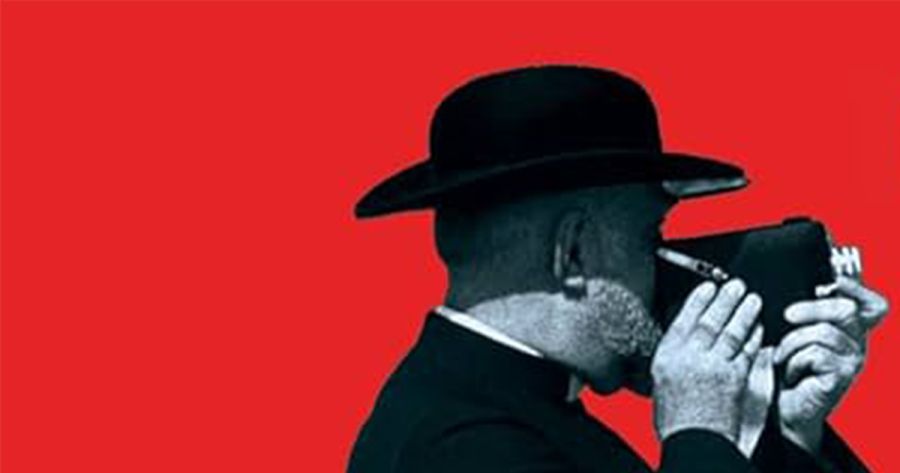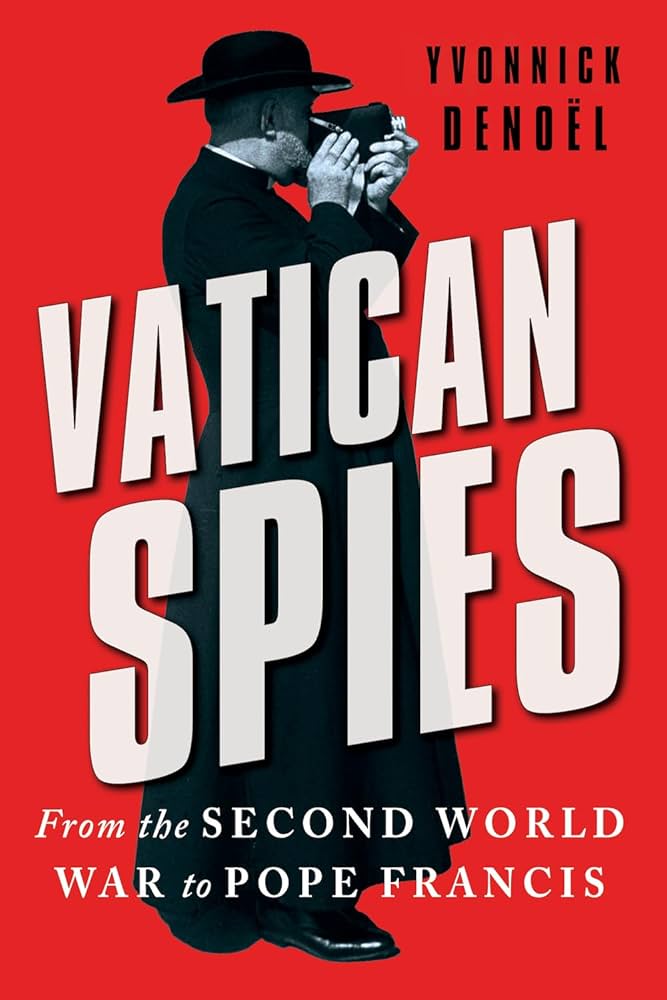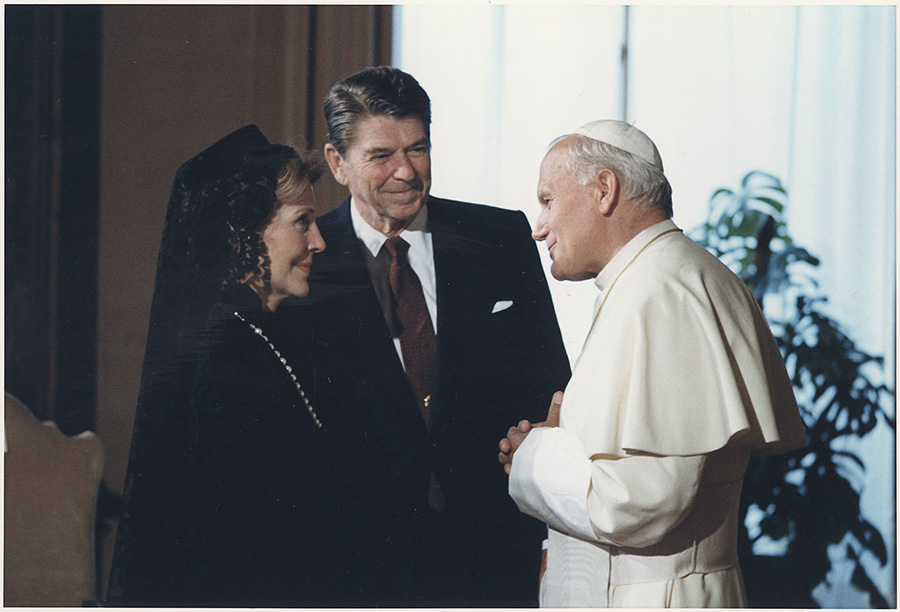
- Free Article: No
- Contents Category: Spies
- Review Article: Yes
- Article Title: Gatling gun of targets
- Article Subtitle: On Vatican subterfuge
- Online Only: No
- Custom Highlight Text:
The global reaction to the recent death of Pope Francis and the ensuing election of Pope Leo XIV confirmed the centrality of the Vatican to its 1.3 billion followers and the international political landscape. The Vatican is the world’s smallest sovereign city-state with a tiny permanent population of 882, yet has immense influence. The intensely hierarchical Holy See is far from transparent. Secrecy, scheming, intrigue, and subterfuge have been the hallmarks of its modus operandi, to which the film Conclave (2024) so grippingly alludes.
- Featured Image (400px * 250px):

- Alt Tag (Featured Image): Phillip Deery reviews ‘Vatican Spies: From the Second World War to Pope Francis’ by Yvonnick Denoël
- Book 1 Title: Vatican Spies
- Book 1 Subtitle: From the Second World War to Pope Francis
- Book 1 Biblio: Hurst, $49.99 hb, 454 pp
- Book 1 Cover Small (400 x 600):

- Book 1 Cover (800 x 1200):

- Book 1 Readings Link: https://www.readings.com.au/product/9781911723400/vatican-spies--yvonnick-denoel--2024--9781911723400#rac:jokjjzr6ly9m
One of the Vatican’s better-kept secrets has been its use of espionage to counter other intelligence agencies’ spies and to defeat real or imagined enemies, especially communists. Ostensibly, this is the subject of Vatican Spies by French historian and intelligence specialist Yvonnick Denoël, who writes that his study examines ‘those who spy on the Vatican just as much as it looks at the priests who confront them or carry out secret duties’. That framework becomes loose and slippery because this book ranges far and wide into extraneous and unrelated topics and uses an enlarged definition of espionage.
But first, what do we learn about ‘Vatican spies’? Denoël begins on the eve of World War II when Pope Pius XII (1939-58) displayed an ambivalence towards the Nazis. Although called ‘Hitler’s Pope’ due to his neutrality, Pius XII sanctioned the sheltering of Jews and provided a sanctuary for escaped Allied soldiers inside the Vatican during the German occupation of Rome (1943-44). This clandestine work was organised by an Irish Monsignor, Hugh O’Flaherty, and was to an extent bankrolled by an American Cardinal, Francis Spellman, who later became a key Cold War link between the Vatican, the CIA, and the White House.
Pius XII remained silent, and therefore complicit, in the face of wartime atrocities and crimes committed by the Croatian organisation Ustaše, which was fascist, anti-Semitic, and anti-Serbian, but pro-Catholic. After the war, Vatican priests enabled the exfiltration of numerous Ustaše members and former SS officers and oiled a network of escape routes, named ‘ratlines’, to Argentina. (Here, as elsewhere, Denoël overlooks existing scholarship, especially Mark Aarons and John Loftus’s 1991 book, Ratlines: The Vatican’s Nazi connection.) The Cold War had commenced and these war criminals, decidedly anti-communist, were back in favour.
The Americans were not bothered by the ratlines, but they were by the communist threat. Without intervention, the 1948 elections in Italy would be won by the Italian Communist Party. Bound by their mutual anti-communism, the CIA and the Vatican became close collaborators. Thanks to vast sums of US dollars and the extensive use of psychological warfare, in which the CIA station chief in Rome, James Jesus Angleton, played a major role, Italy was ‘saved’ from communism. CIA largesse continued into the 1950s with, Denoël asserts without citation, Catholic priests and prelates as the beneficiaries.
Eastern bloc and Russian intelligence services were similarly preoccupied with the Vatican in the Cold War period. They managed the infiltration of agents and informants who got close to the Pope and provided all-important real-time intelligence on the Holy See’s mindset. In Poland, up to fifteen per cent of the country’s Catholic clergy spied on the Church and collaborated with the secret police. But in this secret war, the Vatican fought back. Undercover priests were despatched on special missions to Eastern Europe and Russia to influence opinion and protect Vatican interests.
 First Lady Nancy Reagan, President Ronald Reagan, and Pope John Paul II, Vatican, 1985 (nsf/Alamy)
First Lady Nancy Reagan, President Ronald Reagan, and Pope John Paul II, Vatican, 1985 (nsf/Alamy)
It was in Poland in the early 1980s that the Vatican achieved its greatest success. The former Archbishop of Kraków, John Paul II (1978-2005), intervened decisively in support of Solidarność, a Polish trade union that emerged in 1980, which challenged the authority of Poland’s communist government. It was the high-water mark of his papacy. Already schooled in the dark art of subterfuge, the Pontiff was involved at every level in resisting the communist regime – from channelling hundreds of millions of dollars to underground groups during a period of martial law (1981-83) overseen by General Wojciech Jaruzelski, to providing reprographic equipment and typewriters that were hidden in churches, and to openly and provocatively challenging authorities during papal pilgrimages to his native Poland between 1979 and 1987. This is a familiar and well-trodden story but Denoël, who credits John Paul II with being the ‘chief engineer’ of ending Soviet domination in Poland and elsewhere, tells it effectively.
In this lengthy ‘Polish Crusade’ chapter, Denoël certainly makes the case for framing his narrative in terms of the book’s title: there were double agents, clandestine networks, safe houses, illegal newspapers, concealed printing presses, psychological warfare, transmission of US intelligence to the Pope, and the furtive bankrolling of Solidarność via the secretive and ultra-conservative Opus Dei. The same cannot be said for many other chapters.
Numerous postwar events, developments, and scandals throughout the successive pontificates of popes are, at most, only tangentially related to spies and espionage conducted by or against the Vatican. Take, for example, Denoël’s frequent excursions into the Vatican’s finances. The Vatican bank (officially known as the Institute for the Works of Religion) is completely independent, has published no accounts, and is exempt from all regulations. On a vast scale throughout all papacies from 1942, it has been involved in bribery, money laundering, speculation, extortion, shadowy cabals, bogus accounts (such as the non-existent Cardinal Spellman Foundation), and been associated with the Mafia. Denoël documents all this and more, but it has nothing to do with ‘Vatican spies’.
Also not obviously relevant to the question of Vatican spies are the Holy See’s relationships to the genocide in Rwanda, liberation theology in Latin America, the Pinochet regime in Chile, religious repression in China, the recognition of Israel and sympathy for Palestinians, the kidnapping of Aldo Moro, and international diplomacy exemplified by negotiations between John XXIII and Nikita Khrushchev. Conspiracy theories are raised but not evaluated. The sheer plethora of topics and scandals reminded me of a Gatling gun rapidly firing at multiple, undifferentiated targets largely unconnected from each other. Compounding this are the bewildering number of names and organisations that blur concentration and blunt analysis. One almost needs the help of the Holy Spirit to navigate the relentless accumulation of indigestible detail.
Denoël commented that his biggest difficulty was ‘organizing all that information and giving it a coherent meaning’. He did not succeed. On the final page, he admits that ‘Vatican spies … don’t have much to do with the realities we have come across in this book’. Indeed. Had he stuck to his primary theme and not overwhelmed the reader with ‘all that information’, the book would have been half the size. It needed a sharper focus, a stronger narrative arc, and a more rigorous editorial hand.
A less fundamental criticism concerns sources and scholarship. To claim that Vatican Spies is based on ‘freshly released archives’ is disingenuous. Archival research has been undertaken, but (with six exceptions) by authors of secondary sources whom Denoël then cites. None of these publications, on which Denoël relies heavily, is given relevant page numbers. Numerous quotations and assertions lack references. So, despite glowing reviews from both sides of the Atlantic and several intriguing chapters, Vatican Spies remains a missed opportunity.


Comments powered by CComment